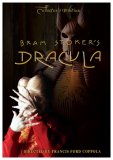| Reviews & Columns |
|
Reviews DVD TV on DVD Blu-ray 4K UHD International DVDs In Theaters Reviews by Studio Video Games Features Collector Series DVDs Easter Egg Database Interviews DVD Talk Radio Feature Articles Columns Anime Talk DVD Savant Horror DVDs The M.O.D. Squad Art House HD Talk Silent DVD
|
DVD Talk Forum |
|
|
| Resources |
|
DVD Price Search Customer Service #'s RCE Info Links |
|
Columns
|
|
|
Bram Stoker's Dracula - Collector's Edition
THE MOVIE:
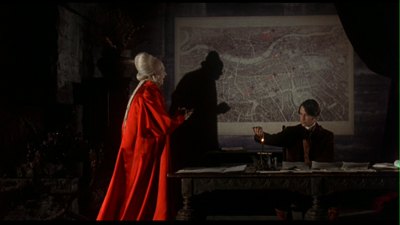
There have been at least three DVD versions of Bram Stoker's Dracula released over the years, not counting international editions or its bundling with the Kenneth Branagh film Mary Shelley's Frankenstein. All of these have been considered woefully inadequate for various issues, either due to some complaints about the picture or the noticeable lack of extra features. Given that this was a film made by Francis Ford Coppola, one of America's greatest and at times most disappointing directors, and that it was the only decent film he's made in the last fifteen years, the handling of Dracula in this format seemed like a horrible miscarriage of cinematic justice. Memories of a Criterion laser disc, complete with commentary and supplements, haunted DVD forums, followed closely by the specter of persistent rumors that a more flashy special edition was on its way.
Those rumors were so persistent, every time I would break down and think I should finally give in and buy one of the discs that was out there, a quick search for which one to buy would yield yet again that this holy grail of upgrades was just around the corner. The chatter would scare me off once more, patience winning out, supported by a healthy fear of the dreaded DVD double-dip. Cut ahead to now, and my patience has been rewarded.
Mulling over this as I loaded the new two-disc Bram Stoker's Dracula - Collector's Edition into my player, I realized that as a result of this waffling, I hadn't actually seen the movie in at least ten years. My only vivid memory of seeing the whole thing was its original theatrical release in 1992, though I am sure I caught pieces of it on cable in the interval. In that time, my memory of the film was that it was visually stunning but a little muddled as far as story; upon reaching the closing credits this time around, I was pleasantly surprised to have found that it was only my memory that was muddled, and that Coppola's bodice-ripping horror tale was successful on just about every level.
The tale of Dracula is the stuff of literary, cinematic, and pop culture legend. Even if finer details have changed, the basic plot has stayed pretty much the same since Bram Stoker wrote his novel in 1897, though the purported intention of James V. Hart's script for this particular film version was to go back to Stoker's text as much as possible, while mixing in a little pseudo-history in the process.
Count Dracula, once known as Vlad the Impaler and played with a wanton bloodlust by an appropriately hammy Gary Oldman, renounced God and the boundaries of human life upon the death of his beloved bride (Winona Ryder). Feasting on blood, he has found a semblance of eternal life as an undead, mystical creature, terrorizing his former species and creating equally bloodthirsty disciples. Destiny intervenes when the Count is visited in Transylvania by a British realtor, Jonathan Harker (Keanu Reeves), whose fiancée Mina has the good fortune of being played by the same actor as the Count's dead love, and so is a dead ringer for that dead love.
Packing up boxes of Transylvanian dirt to preserve his crusty existence, Dracula travels to England, finds Mina, and attracts the attention of several well-meaning horndogs when he seduces their favorite object of desire, Lucy (a wonderful Sadie Frost). This attracts the attention of semi-deranged scientist and vampire hunter Professor Van Helsing (Anthony Hopkins), setting up the scenario for the classic hunt, pursuit, and killing of the monster.
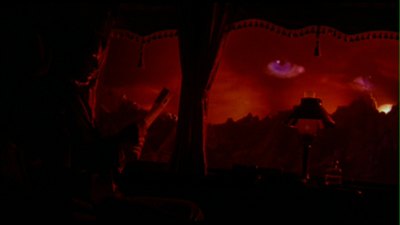
The greatest thing to recommend Coppola's adaptation of Dracula is what a stunning visual tour de force it is. You can actually see some early foundation work for the kind of gonzo super-cutting that Oliver Stone would utilize a couple of years later in Natural Born Killers, but the truly impressive thing about Coppola's film is that all of the effects were done "in camera." A film historian, the director dug into the bag of tricks left behind by the past masters, creating a surreal, psychedelic string of special effects that recall the impressive moves made by the architects of the old Universal horror films but also silent cinema pioneers. Coppola, along with expert cinematographer Michael Ballhaus and second-unit director Roman Coppola, achieves an effectively antique look in the movie without ever really calling attention to it. The careful construction of the heady narrative allows for a seamless package where we are stunned by the effects enough to wonder how they did it, but sucked into the story enough that we can barely pause for the question.
What this does is immerse the viewer in a complete state of "otherness." Dracula isn't just luring Mina and Lucy over to the dark side, but Coppola whips up an atmosphere of murderous passion and tempestuous desire for his audience, transporting us out of our comfortable chairs and into a dizzying world of sensory overload.
In this, he is ably assisted by his actors. Oldman is a force of nature unto himself, truly shining as the mercurial Count. The character has multiple guises, and the actor makes every hideous costume work. Likewise, Coppola has unleashed something in Anthony Hopkins, who goes a bit nuts as the manic Van Helsing. His performance can be a tad over-the-top, but it must have been hard not to want to chase after Oldman and try to match him blow for blow. There is also an excellent supporting cast that includes Cary Elwes, Bill Campbell, Tom Waits, and Richard E. Grant. It's only the younger stars who are a little out of their element. Winona Ryder has her moments where she moves from being convincing to coming off as a little girl playing dress-up. (I had similar problems with her in The Age of Innocence.) Even worse is the truly bad Keanu Reeves. Not only had the actor not mastered the English accent, but he had yet to master his own body. A controlled and often imposing physical presence in his more recent action roles, his poise and demeanor here still scream of Theodore Logan. Though, to be fair, the worst performance in Bram Stoker's Dracula is given by Keanu's wig in the insane asylum scene. It looks like it just wandered off the set of a George Washington biopic and maliciously jumped on his head like some kind of scalp-sucking vampire wig.
By the extremely satisfying and gorgeous final shot of Bram Stoker's Dracula, I felt bloated with the visual feast I had partaken in. The release achieved in the final, heinous deed works as a release for the audience, too. I was so wrapped up in what was happening, I can only applaud Coppola for his avoidance of any coda or denouement. Better to rest on the power of that last image, let it sit in our brains, than spend any time reassuring us that life goes on. Sure, in that sense, Dracula wins, but such is the case of any great villain. For as nasty as their comeuppance can get, they remain as vivid, insidious, and alluring as they were at the height of their powers--and we remain their disciples.
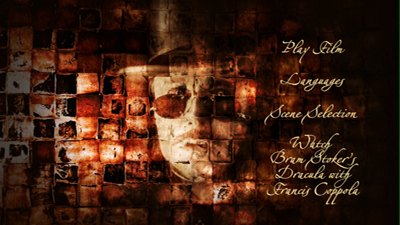
THE DVD
Video:
There is plenty to be happy about with the new Bram Stoker's Dracula - Collector's Edition, and the picture quality is one of them. As noted, I don't have the older versions of the DVD, but this 1.85:1 anamorphic, hi-def transfer is pretty sweet. The colors are rich and varied, and the dark blacks in a very dark film go deep. It appears to be a very meticulous job, overseen by the director, and utterly free of compression, glitches, or dirt.
EDIT/UPDATE: Now that DVD Talk has a review of the Blu-Ray version of this movie, written by Daniel Hirshleifer, it's worth noting that there has been some controversy surrounding the transfer as it pertains to that format. Personally, I don't find that the criticism is founded for the regular edition, and feel this may be a case of some newer technology getting the better of an old movie (you remember when CDs carried warnings about the new mixing exposing flaws?). I will concede some graininess in some outdoor night scenes, but to my eye, it appeared to be more effect than flaw. I've also seen this ably defended elsewhere in regards to Coppola's intended "old time" look. It's mere speculation that this movie does not conform to Coppola's intentions, which we have so far been led to believe it does. I stand by my assessment. You can discuss it further in our forums if you're still not satisfied.
Sound:
There is a cornucopia of sound options here, including 5.1 Dolby mixes in English and French, a surround mix in Spanish, and an added dub in Portuguese, as well as subtitles in all of these languages, Korean, and even a Closed Captioning option. These subtitles are available for the commentary track as well as on the lead audio feature.
The English option sounded very good to me, with plenty of atmosphere and volume. I particularly noticed how nice and full Wojciech Kilar's score sounded.
Extras:
Bram Stoker's Dracula - Collector's Edition is a two-disc affair. The interior case is a cardboard book with a plastic tray set up to hold both discs at staggered heights. This "book" then slides into an outer slipcase. Both pieces have a shiny, color-printed finish and the outer cover has an embossed logo. I actually really love the design of the new package, falling for its charms even before removing the shrinkwrap. I noticed the gorgeous cover image right away.
The first disc, of course, has the movie, as well as the option to "Watch Bram Stoker's Dracula with Francis Ford Coppola," which adds a four-minute video introduction to the picture and the director's full-length audio commentary. The best commentary tracks are the ones that come with some perspective, and fifteen years is certainly a good length of time for any director to have a better understanding of what it was they accomplished. Given the complexity of Bram Stoker's Dracula, Coppola has plenty to draw from, and he goes into great detail about what he wanted to achieve and how he did it.
Disc 2 is the bonus feature disc, housing four documentaries, deleted scenes, and trailers. Before I dig in, I wanted to mention one thing: when this DVD was loaded into my Korean DVD player, the menus all appeared in Japanese with no option for me to fix it. This was a little troublesome, as this is not a very straightforward DVD where you can just hit play and let it run, there are a lot of options here. On my laptop, it loaded up fine. So, be forewarned, if you have all-region players imported from outside North America, you could encounter the same problem.
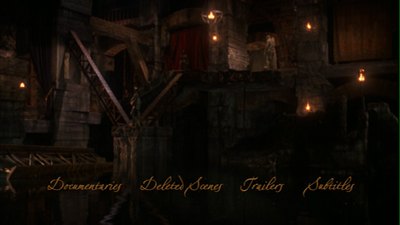
Four new documentaries, together clocking in at just over an hour, explore various aspects of the production in exacting detail:
The Blood is Life - The Making of Dracula (29 minutes): Your standard making-of, with tons of on-set footage and interviews with cast and crew from 1992.
The Costumes and the Sets - The Design of Eiko Ishioka (14 mins.): An excellent overview of the special costumes created by the Japanese designer, including lots of sketches and footage from the creation of the material. Includes our first look at new interview shots with Coppola.
In-Camera - The Naïve Visual Effects of Dracula (19 mins.): Hosted by Roman Coppola, with new interviews with his father and the other father/son effects team of Christopher Warren and Gene Warren, Jr., this is an awesome little documentary showing how they achieved all the amazing special effects using only old school techniques. Anyone with even just a passing interest in doing effects work, or folks mystified by movie magic, should give this featurette a look.
Method and Madness - Visualizing Dracula (12 mins.): A showcase of the paintings and other non-movie sources that inspired the look of the film, special rehearsal footage, and the unique storyboarding sessions that allowed the Coppolas to get their special look. Another cool documentary.
Twelve deleted and extended scenes, which you can choose individually or in a "play all" function, total at just under half an hour, not over it as the box claims. Some of this footage is rough, and there is even an inclusion of storyboard elements in the very first scene. These are good as far as this kind of material goes, but there is nothing too revelatory included. Most of the trims are obvious, dispensing with unneeded exposition and some particularly wearying voiceover from Reeves and Ryder. It is neat to see how some scenes were dismantled so that pieces of them could be used elsewhere in the movie, such as how bits from when Harker finds Dracula's sleeping chamber ended up being his escape instead. A couple of scenes from Dracula's voyage to England show a few more shots of him in his wolfen guise, and an extended ending gives the movie the final uplifting swell that I was happy not to see close the picture.
These extras are subtitled in Japanese, Portuguese, Spanish, and Korean, but not English or French.
Finally, there are quite a few trailers, including two different ones for Bram Stoker's Dracula and a bunch for other Sony titles.
Overall, this DVD package should be applauded for having no stinkers in the extras bin. No cursory filler, and no recycling of elements from one documentary to another. Everything is unique and self-contained, and all of the material informs the audience's enjoyment of the movie the extras support.
FINAL THOUGHTS:
DVD Talk Collector Series. Bram Stoker's Dracula - Collector's Edition is a revelation on its fifteenth anniversary. Visually stunning, it's a lusty back-to-basics adaptation of the original novel, featuring gorgeous costumes, clever effects, and outstanding performances from Gary Oldman, Sadie Frost, and Anthony Hopkins. Long neglected in the DVD format, this new double-disc release spruces up the image and sound of the movie and adds a host of well-crafted bonus features. Both spooky and romantic, Bram Stoker's Dracula is a fine showing for Francis Ford Coppola, and easily on par with his 1970s work. If you haven't been to Transylvania in a while, book your passage. It's time to revisit the Count!
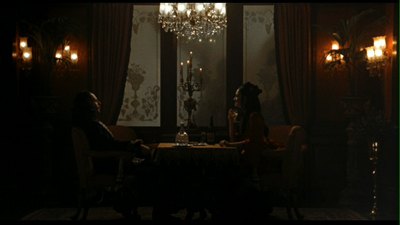
Jamie S. Rich is a novelist and comic book writer. He is best known for his collaborations with Joelle Jones, including the hardboiled crime comic book You Have Killed Me, the challenging romance 12 Reasons Why I Love Her, and the 2007 prose novel Have You Seen the Horizon Lately?, for which Jones did the cover. All three were published by Oni Press. His most recent projects include the futuristic romance A Boy and a Girl with Natalie Nourigat; Archer Coe and the Thousand Natural Shocks, a loopy crime tale drawn by Dan Christensen; and the horror miniseries Madame Frankenstein, a collaboration with Megan Levens. Follow Rich's blog at Confessions123.com.
|
| Popular Reviews |
| Sponsored Links |
|
|
| Sponsored Links |
|
|
| Release List | Reviews | Shop | Newsletter | Forum | DVD Giveaways | Blu-Ray | Advertise |
|
Copyright 2024 DVDTalk.com All Rights Reserved. Legal Info, Privacy Policy, Terms of Use,
Manage Preferences,
Your Privacy Choices | |||||||









